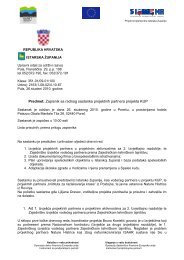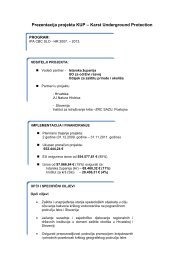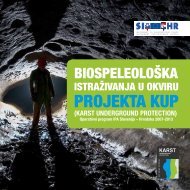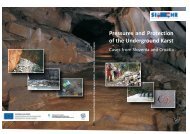prvi hrvatski speleološki kongres - KARST underground protection
prvi hrvatski speleološki kongres - KARST underground protection
prvi hrvatski speleološki kongres - KARST underground protection
Create successful ePaper yourself
Turn your PDF publications into a flip-book with our unique Google optimized e-Paper software.
esearch, while cavers are organised in Jamarska zveza Slovenije which in<br />
collaboration with institute builds the cave register.<br />
First cave exploration in the catchment area of Ljubljanica was rather easy.<br />
There were many large entrances and large easy passable caves beyond. The obstacles<br />
were overrun according to available technique and knowledge. By the end of 19.th<br />
century portable boats were used and deep caves to depth of 220 m were explored<br />
with winches and ladders. Some digging and blasting were also involved. First diving<br />
was done in 1930s, and main connections of the caves trough sumps were made after<br />
1960.<br />
Today main work is on searching for new entrances, enlarging the narrow<br />
entrances or passages or diving in sumps. In the year 1983 there were 647 caves<br />
known in the basin of Ljubljanica river. By the end of 2010 there are 1661. Mean<br />
length of the cave is 82 m, depth 18 m. The total length of all cave passages is 136<br />
km. But 10 the longest caves with total length is 66 km are all along <strong>underground</strong><br />
course of segments of Ljubljanica river or tributaries.<br />
These caves are Postojnska jama, Kriţna jama, Karlovice, Planinska jama,<br />
Najdena jama, Zelške jame, Logarĉek, Gašpinova jama, Tkalca jama and Dihalnik v<br />
Grdem dolu.<br />
The search for the galleries where Ljubljanica flows <strong>underground</strong> is the main<br />
challenge for the cavers in the area. From the surface it was achieved only four times:<br />
trough deep shafts of Gradišnica 1886, digging in the passage in Najdena jama in<br />
1962, enlarging the entrance of the blowhole in cave Dihalnik v Grdem dolu in<br />
(1992) and Vetrovna jama in 2002.<br />
Reka is a surface river that sinks in the SE edge of 600 km 2 large Kras<br />
plateau. At the ponor into Škocjanske jame cave mean annual discharge of river is 8.2<br />
m 3 s -1 . After 35 km of the <strong>underground</strong> flow it appears at spring as river Timavo at the<br />
coast of Adriatic Sea. River is now larger since it gets discharge from whole Kras<br />
plateau.<br />
The plateau and karst phenomena, specially sinking rivers and springs are<br />
mentioned in antiquity already. First cave mentioned later is Vilenica, which was in<br />
1613 already managed cave for tourism. Great part of the cave research was always<br />
connected with water supply for Trieste and searching for the <strong>underground</strong> Reka river.<br />
Systematic speleological research started in Labodnica in 1841 by Lindner and in<br />
Škocjanske jame caves in 1839 by J. Svetina. It was followed by A. Schmidl and after<br />
1884 by A. Hanke and J. Marinitsch from speleological section of DOAV alpine club<br />
from Trieste. By 1889 the cave was explored till terminal sump.<br />
Search for the <strong>underground</strong> river beyond Škocjanske jame followed. Many<br />
caves were found and explored. After WW I the caves from the area were published<br />
in monograph Duemila Grotte (1926) and Il Timavo (1938). At about the same time<br />
the first diving attempts were made in the caves at the springs of Timavo.<br />
Today the state border is dividing the Kras plateau so then data about caves<br />
are collected by speleologists in Slovene and Italian cave registers. On the Kras<br />
plateau above the <strong>underground</strong> Reka there are 2131 known caves. Total length of the<br />
cave passages is 126 km, mean length 60 m, and mean depth 27 m.<br />
The main discoveries, longest, deepest and most important caves in the area<br />
are along the <strong>underground</strong> Reka. First to reach the <strong>underground</strong> flow of Reka were<br />
A.F. Lindner and J. Svetina in the year 1841 in 329 m deep cave Labodnica or Grotta<br />
di Trebiciano at Orlek. The cave was after that for 68 years the deepest cave of the<br />
world. Next discovery of <strong>underground</strong> river was only in 1972 in Kaĉna jama, and then<br />
cave is today 14 km long and 270 m deep.<br />
88










